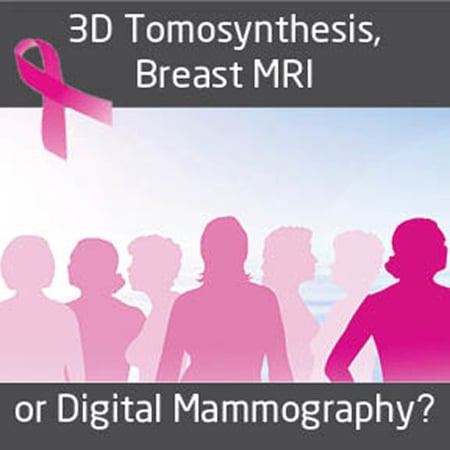There’s nothing more effective in treating breast cancer than early detection. So once you get a patient in for an annual exam, which is the best technology to use? Let’s take a look at the three ways to image a  patient’s breasts: MRI, tomosynthesis, or digital mammography.
patient’s breasts: MRI, tomosynthesis, or digital mammography.
Traditional mammography uses low doses of radiation to image the breast. The procedure is uncomfortable, awkward and often painful. Most women have come to dread their annual exams because of this traditional form of imaging. In fact, there are many cartoons that illustrate this. However, there are some forms of cancers that can ONLY be seen with mammography—so it still has value in clinics, practices and healthcare facilities. At the same time, it’s important to remember that some tumors do not show up in traditional mammograms.
Breast MRI uses a powerful magnet to image the breast, without radiation exposure. It’s a relatively new, highly specialized test that takes approximately 45 minutes. In fact, it hasn’t even been standardized in the U.S. yet, and there is no research or study to date that documents the overall mortality reduction from Breast MRI.
During the MRI imaging process, the patient must remain very still, which can make the patient a little uncomfortable. However, this procedure is more sensitive at detecting the most invasive cancers, as well as the majority of non-invasive cancers. It’s also capable of finding tumors that traditional mammography can’t. While an MRI is more sensitive than mammography, it can also deliver false positives, which can lead to unnecessary follow-up imaging and/or biopsies. That’s why it’s also important to inform your patients to schedule mammography appointments at days 3-14 in a normal menstrual cycle, as some false positives are related to hormonal activity. Breast MRI studies are ideal for women with silicone breast implants and those when breast cancer recurrence is suspected. It’s also ideal for high risk patients, with a 20-25% lifetime risk, or those with hard-to-asses abnormalities. It’s also important to remember that patients with metal present in their bodies or pacemakers should not undergo MRI studies, nor should patients with contrast agent allergies.
Digital Breast Tomosynthesis is yet another kind of mammogram that takes three-dimensional images of the breast. While this geometric or linear technology has been around since the 1930s, it’s only recently been applied to mammography. This 3D technology can improve the accuracy of mammography and clarify images of overlapping tissue. It only uses minimal pressure and is less uncomfortable for patients. A tomosynthesis-equipped machine can also perform 2D, 3D and a combination of both during a single compression. As this procedure becomes available at more facilities and becomes less expensive, it is expected to replace conventional mammography.
In the future, you can expect to see an increase in the use of mammography plus breast tomosynthesis, in order to decrease the number of women who undergo unnecessary recalls or biopsies.
Since tomosynthesis is relatively new, there aren’t many refurbished or used units available. There are a wide variety of digital mammography units that enable you to offer your patients ideal imaging, at a much lower cost than investing in new technology. It’s wise to talk to an expert about the needs of your clinic or practice and see what your best option would be. Why not contact Atlantis Worldwide today?
Please contact Alex Silbergleit at 212-366-9100 or email alex@atlantisworldwide.com
Some blogs you may have missed:
- 3 Top Components Make Your Digital Mammography Procedure Easier
- CAD + Mammography: The Perfect Combination
- 3 Considerations When Choosing a Digital Mammo System
- Choosing A Digital Mammography System: GE vs. Hologic
- Free Women Health Resources
Meet the author: Vikki Harmonay




